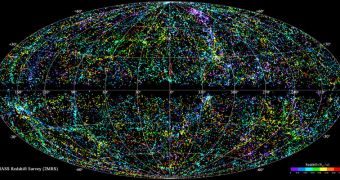After more than a decade of surveys, experts finally managed to wrap up work on the most complete, detailed, 3D map of the local Universe ever developed. The map covers an area extending more than 380 million light-years into space
One of the most impressive achievements of the 2MASS Redshift Survey (2MRS) is that it managed to get closer to the galactic plane of the Milky Way than any other study of this kind.
The area surrounding the core of our galaxy is generally obscured by massive clouds of cosmic dust, which makes observations in the visible-light portion of the electromagnetic spectrum nearly impossible, experts say.
But experts with the new research effort were able to surpass this obstacle to some extent, according to University of Portsmouth expert Karen Masters. She presented the new map at a press conference held today, May 25, during the 218th meeting of the American Astronomical Society (AAS 2011).
“The 2MASS Redshift Survey is a wonderfully complete new look at the local Universe – particularly near the Galactic plane,” the expert explains. She adds that the redshift of all the galaxies in the studied perimeter were also established.
“We're also honoring the legacy of the late John Huchra, an astronomer at the Harvard-Smithsonian Center for Astrophysics, who was a guiding force behind this and earlier galaxy redshift surveys,” Masters told reporters.
The redshift of a galaxy is the amount to which the blue light the cosmic structure emits is shifted towards the red portion of the visible-light spectrum. The longer the distance between Earth and a galaxy, the larger the redshift, astronomers explain.
When compiling a 3D map of the Universe, knowing the third dimension, in this case depth, is essential, and the team that ran 2MRS was very well aware of that. The Two-Micron All-Sky Survey (2MASS) was an inspiration for the current investigation.
The former scanned the entire sky in 3 near-infrared wavelength bands, and some of the galaxies that the 2MRS Collaboration mapped were selected directly from the 2MASS results. The latter were however only bi-dimensional, and this is where the new map excels.
“John loved doing redshift surveys and he loved the infrared. He had the insight to tell when infrared technology, formerly the province of the experts, was ripe for routine use in a big project,” explains CfA expert Robert Kirshner, who was a colleague of Huchra's.
“John was instrumental in setting up the 2MASS telescope at Mount Hopkins, seeing the infrared side of the project through, and making a much more complete survey of the local Universe,” he adds.
“It's a wonderful tribute to John that his colleagues have finished the infrared-selected galaxy redshift survey that John started,” the CfA expert concludes.

 14 DAY TRIAL //
14 DAY TRIAL //